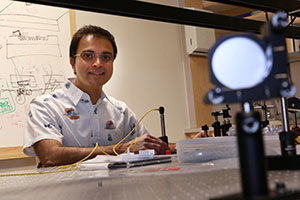
University of Utah engineers have taken a step forward in creating the next generation of computers and mobile devices capable of speeds millions of times faster than current machines.
The Utah engineers have developed an ultracompact beamsplitter — the smallest on record — for dividing light waves into two separate channels of information. The device brings researchers closer to producing silicon photonic chips that compute and shuttle data with light instead of electrons. Electrical and computer engineering associate professor Rajesh Menon and colleagues describe their invention today in the journal Nature Photonics.
Silicon photonics could significantly increase the power and speed of machines such as supercomputers, data center servers and the specialized computers that direct autonomous cars and drones with collision detection. Eventually, the technology could reach home computers and mobile devices and improve applications from gaming to video streaming.
“Light is the fastest thing you can use to transmit information,” says Menon. “But that information has to be converted to electrons when it comes into your laptop. In that conversion, you’re slowing things down. The vision is to do everything in light.”
Photons of light carry information over the Internet through fiber-optic networks. But once a data stream reaches a home or office destination, the photons of light must be converted to electrons before a router or computer can handle the information. That bottleneck could be eliminated if the data stream remained as light within computer processors.
“With all light, computing can eventually be millions of times faster,” says Menon.
Read the full press release in the U News Center.